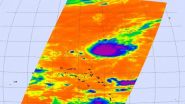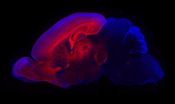(Press-News.org) PHOENIX, Ariz. -- July 15, 2015 -- Researchers at the Translational Genomics Research Institute (TGen) have identified a genetic mutation associated with the appearance of premature aging and severe loss of body fat in children.
TGen's Center for Rare Childhood Disorders found that the appearance of premature aging, a neonatal form of Progeroid syndrome, in a 3-year-old girl was caused by a mutation in the gene CAV1, according to a study published today in the scientific journal PLOS ONE.
The Center for Rare Childhood Disorders was established in 2010 to examine the genetic basis of disease in children with medical conditions that have no definitive diagnosis. Since its inception, the Center has enrolled more than 900 participants and analyzed the genomes of more than 200 families, with a diagnostic success rate of nearly 40 percent.
Progeroid syndromes are a group of rare genetic disorders that mimic physiological aging, making affected individuals appear to be older than they are. In this instance, the patient has a triangular appearance to her face, and a large area at the top front of the head where a growing young child's cranial bones eventually fuse together known as the anterior fontanelle.
The CAV1 mutation was discovered following genomic sequencing of the girl and her parents, in which the billions of pieces of information in their DNA were spelled out, using TGen's state-of-the-art technologies and capabilities for whole-genome sequencing.
"Having a diagnosis is a major step in the continuing care of our patients," said Dr. Matt Huentelman, Co-Director of TGen's Center for Rare Childhood Disorders and the study's senior author. "This is a unique discovery and a prime example of how children born with rare, undiagnosed conditions may benefit from a diagnosis obtained through genetic sequencing."
The young patient in this study also has a form of high blood pressure (pulmonary hypertension) that specifically affects the heart and lungs. She also has had a feeding disorder, and a failure to thrive. In addition, she has symptoms of lipodystrophy, a medical condition characterized by a severe loss of body fat. Patients with lipodystrophy have a tendency to develop insulin resistance, diabetes, high triglyceride levels, and fatty liver.
"We characterize further association of CAV1 dysfunction with a syndrome of severe premature aging and lipodystrophy, showing clearly how these specific genetic changes expand the spectrum of CAV1-associated disorders" said Dr. David Craig, Co-Director for TGen's Center for Rare Childhood Disorders, and another author of the PLOS ONE scientific paper.
The CAV1 gene codes for Caveolin 1, a key protein in the plasma membrane of individual cells. The plasma membrane surrounds the cell and contains a multitude of molecules that enable the cell to send and receive information to and from the environment. Caveolin 1 helps regulate many cellular functions, including tumor suppression; but also vesicle trafficking, the movement of important biochemical signal molecules through vesicles in the cell, or the traffic of molecules between different membrane-enclosed compartments in the cell; and cellular senescence, the phenomenon in which cells stop growing and dividing.
"This study may contribute to a better understanding of the pathogenic mechanisms that contribute to the severe reduction of body fat, the appearance of premature aging, as well as the serious medical problems that affect our patient," said Dr. Vinodh Narayanan, Medical Director of TGen's Center for Rare Childhood Disorders, and also an author of the PLOS ONE paper. "Such understanding may lead to better approaches to her treatment, and allow us to anticipate, detect and treat complications before they become severe."
The patient's lack of body fat could be due to the cumulative combination of the defective functions not only of the CAV1 gene, but also of the LPIN1 and ADPAT2 genes, the study said.
Despite her premature aging appearance, the patient shows no neurological problems, said Dr. Isabelle Schrauwen, a Research Assistant Professor in Dr. Huentelman's lab and the lead author of the scientific paper.
"She has been active, playful, interactive and well spoken. In fact it has always been such a treat to see her smiling face at our Center outreach events," Dr. Schrauwen said. "We really owe a debt of gratitude to her, her family, and all of the families who work with us at the Center. Without their commitment to research we wouldn't be where we are today."
INFORMATION:
The Center for Rare Childhood Disorders is co-directed by Drs. Huentelman, Narayanan and Craig. The Center has established collaborations that stretch across the globe.
The authors of the paper thank the patient and her family for participating in this groundbreaking research as well as the donors who support the ongoing work in TGen's Center for Rare Childhood Disorders.
The study published today in PLOS ONE is titled: A Frame-Shift Mutation in CAV1 Is Associated with a Severe Neonatal Progeroid and Lipodystrophy Syndrome.
About TGen
Translational Genomics Research Institute (TGen) is a Phoenix, Arizona-based non-profit organization dedicated to conducting groundbreaking research with life changing results. TGen is focused on helping patients with cancer, neurological disorders and diabetes, through cutting edge translational research (the process of rapidly moving research towards patient benefit). TGen physicians and scientists work to unravel the genetic components of both common and rare complex diseases in adults and children. Working with collaborators in the scientific and medical communities literally worldwide, TGen makes a substantial contribution to help our patients through efficiency and effectiveness of the translational process. For more information, visit: http://www.tgen.org.
Press Contact:
Steve Yozwiak
TGen Senior Science Writer
602-343-8704
syozwiak@tgen.org
15 July, 2015, Hoffman Estates, IL - Sodium intake in the U.S. exceeds dietary recommendations and has been identified as a nutrient of public health concern in the Scientific Report of the 2015 Dietary Guidelines Advisory Committee1 due to its link to increased risk of hypertension, heart disease, and stroke2. While authorities continue to call for people to lower their sodium intake, much progress still needs to be made and multiple solutions are necessary to meet the recommended maximum intake of 2,300 milligrams per day for the general population and 1,500 milligrams ...
Mainz/Barcelona. A team of scientists at the Max Planck Institute for Polymer Research (MPI-P) discovered that electrical conduction in graphene on the picosecond timescale - a picosecond being one thousandth of one billionth of a second - is governed by the same basic laws that describe the thermal properties of gases. This much simpler thermodynamic approach to the electrical conduction in graphene will allow scientists and engineers not only to better understand but also to improve the performance of graphene-based nanoelectronic devices.
The researchers found that ...
Researchers at Harvard University and the University of California, San Diego, have developed a new user-friendly resource to accompany the powerful gene editing tool called CRISPR/Cas9, which has been widely adopted to make precise, targeted changes in DNA. This breakthrough has the potential to facilitate new discoveries in gene therapies and basic genetics research. The research was published in the July 13 issue of Nature Methods.
The study describes an approach to simplify a laborious part of the gene editing process using the CRISPR/Cas9 system: choosing the best ...
Sudden unexpected death in epilepsy (SUDEP) is becoming increasingly recognized as a very real and devastating problem in which impaired breathing is thought to play a critical role. Researchers believe breathing may be impaired during and after seizures, without the patient's knowledge.
By using electrical stimulation to activate the amygdala, a group of University of Iowa researchers has identified areas of the human brain in which breathing is controlled and, in some cases, impaired, providing an important insight into SUDEP.
Their study - which marks the first time ...
NASA's Aqua satellite flew over Typhoon Halola in the northwestern Pacific Ocean and captured temperature data on the storm. Satellite data showed that wind shear is affecting the stubborn storm.
NASA's Aqua satellite passed over Halola on July 14 at 20:20 UTC (4:20 p.m. EDT/1:20 p.m. PDT) infrared data from the Atmospheric Infrared Sounder or AIRS instrument that also flies aboard Aqua showed cloud top temperatures were as cold as -63F/-52C. Cloud top temperatures that cold have the ability to drop heavy rainfall.
The Joint Typhoon Warning Center noted that animated ...
High school students who take part in pre-college programs that focus on science are much more likely to pursue higher education and, eventually, careers in science, technology, engineering and medicine - the STEM disciplines.
In a paper published in the Journal of Higher Education Outreach and Engagement, Michigan State University researchers from the National Superconducting Cyclotron Laboratory, the Joint Institute for Nuclear Astrophysics and the College of Education used an MSU program as a case study for why these programs are key to training tomorrow's generation ...
PHILADELPHIA, PA - July 15, 2015 - Obstructive Sleep Apnea (OSA) remains under-recognized in hospitalized patients, despite being associated with cardiovascular complications and sudden death. A multi-disciplinary group of researchers and physicians at Thomas Jefferson University and Hospitals have created a clinical pathway, or screening process, to identify the disorder in higher-risk, hospitalized patients and recently published the results in the Journal of Clinical Sleep Medicine.
"The results showed that our screening process identified sleep disordered breathing ...
New York, NY, July 15, 2015--Researchers at Columbia University Medical Center (CUMC) have found that key parts of the human brain network that give us the power to control and redirect our attention--a core cognitive ability--may be unique to humans. The research, which was published in the July 13 online edition of the Proceedings of the National Academy of Sciences, suggests that the network may have evolved in response to increasingly complex social cues.
"The human brain is powerful, but even it cannot make sense of the entire sum of stimuli that bombard our senses," ...
ROSEMONT, Ill.--Patients who received rehabilitation instructions via video teleconference, or "telerehabilitation," following total knee replacement (TKR) surgery had comparable outcomes to patients who received in-person physical therapy, according to a study appearing in the July 15 issue of The Journal of Bone & Joint Surgery (JBJS).
"This study is the first to provide strong evidence for use of telerehabilitation as an alternative to conventional face-to-face care following total knee replacement surgery," said Hélène Moffet, PhD, lead study author, physical ...
JUPITER, FL, July 15, 2015 - As early as 1943, when autism was first described by psychiatrist Leo Kanner, reports were made that some, but not all, children with autism spectrum disorder have relatively enlarged heads. But even today, more than half a century later, the exact cause of this early abnormal growth of the head and brain has remained unclear.
Now, scientists from the Florida campus of The Scripps Research Institute (TSRI) have uncovered how mutations in a specific autism risk gene alter the basic trajectory of early brain development in animal models.
The ...




